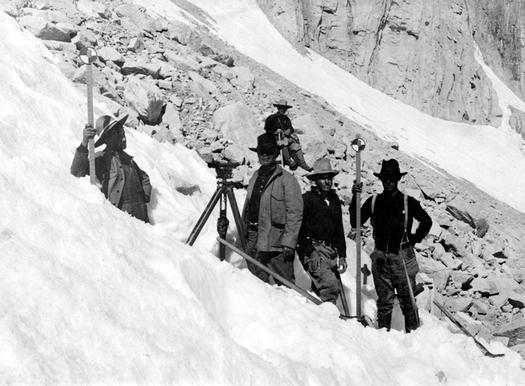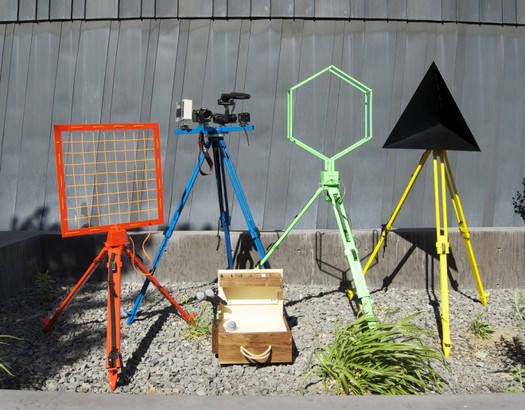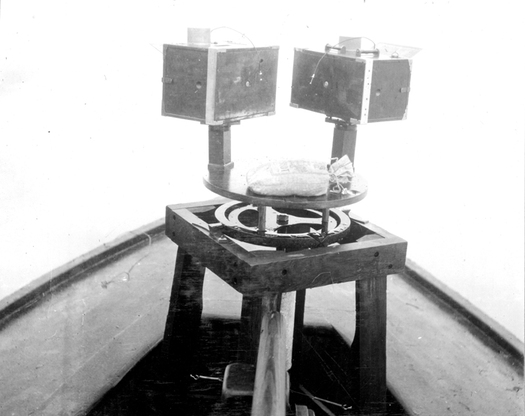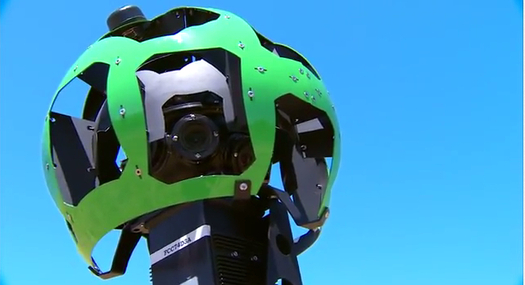
June 27, 2012
Observational Instruments, Observed

Street View Trekker, by Google (video frame)
Rarely do I covet an object on first sight. But man would I love to own a Street View Trekker.
As you can see, it is a preposterous and mesmerizing thing: One of Google’s famous Argus-y camera devices, mounted this time not on a car, but on a human. It protrudes from a sort of backpack, unemotionally but relentlessly documenting … everything. According to Gizmag, it weighs 40 pounds. It’s battery-powered, and equipped with 15 five-megapixel cameras and a hard drive. “There’s a whole wilderness out there that is only accessible by foot,” declares Google’s Lat Long Blog, and thus couldn’t be added to Google’s grand map of the world. Problem solved, I suppose.
I happened to encounter news of the Trekker at about the same time that I was getting up to speed on Venue, a project that Geoff Manaugh and Nicola Twilley recently got underway. This will consist of a series of journeys, over 16 months, across the many landscapes of North America, conducting interviews, collecting idiosyncratic data, and presenting various events. “Its curatorial mission,” the site explains, “is to document often overlooked yet fascinating sites.” It’s a highly ambitious (and quite impressive) project, but the details get a little overwhelming for my purposes here.
I’ll return to some of those details in future posts. For now I’m interested in the stuff they’re hauling around: the equipment, the gear, the instruments. Manaugh has cited land-survey expeditions as a partial inspiration for Venue, and mentioned to Tim Maly of Wired the old photographs of “surveying teams holding huge, visually absurd measuring sticks, like something out of a Dr. Seuss story.”

USGS Photo Library: “U.S. Geological Survey topographic leveling party. … Inyo or Tulare County, California. August 1905.”

USGS Photo Library: “Monument at intersection of Idaho-Washington boundary line with international boundary. Crew holding instruments of the trade. 1908.”
Presumably the devices of topography hauled around in service of the U.S. Geological Survey took (and take) their form from their function, and are not particularly thought of as objects to be observed. Venue’s menagerie of instruments, several designed by Chris Woebken, are just as visually puzzling, but more intentionally so. In this case, in fact, the surprise is that these delightful forms do in fact function.

Venue topographic gear, via Wired
Borrowing the surveyor’s tripod as the starting point, this batch includes an antenna-and-headphones gizmo for listening to normally inaudible earth sounds, and a device that somehow amplifies its own presence to radar trackers (reversing the traditional response to radar: stealth). Venue is having fun, but the project isn’t kidding: There really is topographic/documentary intent here, it’s just willfully, even theatrically, unconventional. It suggests that 120 years after Frederick Turner fretted about the implications of an explored-out North America, it’s still possible to discover new frontiers, all over the place.
The technological capture of those discoveries, thereby making them accessible to others, has long been fundamental to topographic enterprises, always involving image-capture breakthroughs, however curious and unwieldy they may appear. Venue’s gear currently responds to that traditional imperative with the first in what is described as a series of “guest” devices and instruments coming along for part of the ride: Matt Richardson’s Descriptive Camera. It produces its “images” in the form of text descriptions assembled by way of Amazon’s Mechanical Turk.

USGS Photo Library: “Panoramic cameras set up on Gimbal-ring stand aboard launch. Alaska. C. 1910.”

Descriptive Camera, created by Matt Richardson
The subject of documentation obviously brings us back to the Trekker — a Seussian object if I’ve ever seen one. The 30-second video Google has released showing the thing in the wild, as it were, suggests this is a friendly, almost whimsical device: Chipper guitar music plays as a trustworthy-looking fellow surveys the great and sunny outdoors. The big camera-dense ball hovering above his head is a happy shade of green. I can’t be the only person who sees it and thinks: That thing is so cool.
Which is interesting, because one assumes the Trekker is more like old USGS gear than like Venue’s: It’s not really designed to be seen, just to see. So why a snappy promo clip? Possibly because Google’s previously stated mission of capturing the entire world in one massive interactive visual document already freaks people out. And Google knows better than most that things not designed to be seen may get seen anyway. Smarter, perhaps, to introduce us to the Trekker this way, than to wait for some party of hikers to break the news of its existence through a chance encounter with the corporate all-seeing object engaged in environmental surveillance in the middle of some pristine nowhere.
Actually, if the Street View folks are clever, they’ll offer to let the Venue crew give the Trekker a turn as a guest object in their adventure. Venue’s plans for public events during its travels help explain the role of the charismatic instruments it uses, and this one would fit perfectly: Come look at this crazy thing — the one that has done so much looking at us.

A closer look at the Trekker, via Google (video frame)
Observed
View all
Observed
By Rob Walker
Related Posts

Business
Courtney L. McCluney, PhD|Essays
Rest as reparations: reimagining how we invest in Black women entrepreneurs

Design Impact
Seher Anand|Essays
Food branding without borders: chai, culture, and the politics of packaging

Graphic Design
Sarah Gephart|Essays
A new alphabet for a shared lived experience

Arts + Culture
Nila Rezaei|Essays
“Dear mother, I made us a seat”: a Mother’s Day tribute to the women of Iran
Recent Posts
Courtney L. McCluney, PhD|Essays
Rest as reparations: reimagining how we invest in Black women entrepreneurs Food branding without borders: chai, culture, and the politics of packaging Why scaling back on equity is more than risky — it’s economically irresponsible Beauty queenpin: ‘Deli Boys’ makeup head Nesrin Ismail on cosmetics as masks and mirrorsRelated Posts

Business
Courtney L. McCluney, PhD|Essays
Rest as reparations: reimagining how we invest in Black women entrepreneurs

Design Impact
Seher Anand|Essays
Food branding without borders: chai, culture, and the politics of packaging

Graphic Design
Sarah Gephart|Essays
A new alphabet for a shared lived experience

Arts + Culture
Nila Rezaei|Essays

 Rob Walker is a technology/culture columnist for
Rob Walker is a technology/culture columnist for